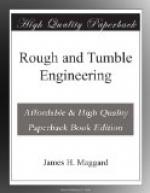Now here is a nice little problem for you to solve and I want you to solve it to your own satisfaction, and when you do, you will thoroughly understand it, and to understand it is to never allow it to get you into trouble. We started out by saying that in a new engine you would most likely find about one-eighth of an inch between the brasses, and we said you would finally get these brasses, or halves together, and would have to take them out and file them. Now we have taken up one-eighth of an inch and the result is, we have lengthened our pitman just one-sixteenth of an inch; or in other words, the center of wrist pin and the center of cross-head are just one-sixteenth of an inch further apart than they were before any wear had taken place, and the piston head has one-sixteenth of an inch more clearance at one end, and one-sixteenth of an inch less at the other end than it had before. Now if we take out the boxes and file them so we have, another eighth of an inch, by the time we have taken up this wear, we will then have this distance doubled, and we will soon have the piston head striking the end of the cylinder, and besides, the engine will not run as smooth as it did. Half of the wear comes off of each half, and the half next to the key is brought up to the wrist pin because of the tapering key, while the outside half remains in one place. You must therefore place back of this half a thin piece of sheet copper, or a piece of tin will do. Now suppose our boxes had one-eighth of an inch for wear. When we have taken up this much we must put in one-sixteenth of an inch backing (as it is called), for we have reduced the outside half by just that amount. We have also reduced the front half the same, but as we have said, the tapering key brings this half up to its place.
Now we think we have made this clear enough and we will leave this and go back to the key again. You must remember that we stated that the key was tapering or a wedged shape, and as a wedge, is equally as powerful as a screw, and you must bear in mind that a slight tap will bring these two boxes up tight against the wrist pin. Young engineers experience more trouble with this box than with any other part of the engine, and all because they do not know how to manage it. You should be very careful not to get your box too tight, and don’t imagine that every time there is a little knock about your engine that you can stop it by driving the key down a little more. This is a great mistake that many, and even old engineers make. I at one time seen a wrist pin and boxes ruined by the engineer trying to stop a knock that came from a loose fly-wheel. It is a fact, and one that has never been satisfactorily explained, that a knock coming from almost any part of an engine will appear to be in the wrist. So bear this in mind and don’t allow yourself to be deceived in this way, and never try to stop a knock until you have first located the trouble beyond a doubt.




